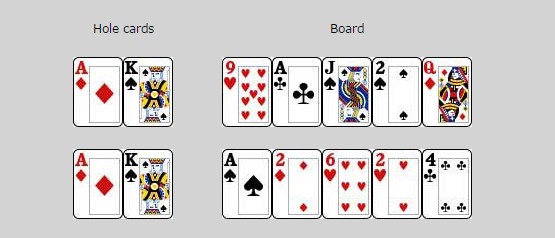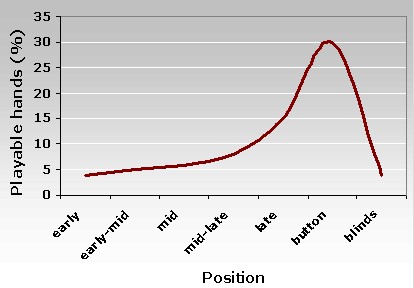An overview of the most important poker strategy fundamentals
Poker is a very complex game. It is a game that involves many subtleties and variables on which the poker player can base his or her decisions. These decisions can sometimes be very creative or risky. They can be planned out over multiple streets of betting, culminating in an elaborate bluff on the river with an absolute rubbish hand.
But before a poker player will be able to make functional creative and elaborate plays it is very important for this player to have a solid ABC-game at his or her disposal. That is: being aware of the most important subtleties and variables on which to base your decisions; being able to make the correct decisions in at least the most 'standard' spots and to some extent being able to differentiate between functional creativity and unnecessary 'fancy play syndrome' (FPS): a solid foundation in poker strategy.
The purpose of this strategy guide is to provide you with exactly this kind of poker strategy foundation for no limit Texas hold'em. If you are able to master the basic principles outlined here and combine this with the necessary discipline and patience to correctly implement them at the tables, then you are well on your way to beating at least the micro stakes for a healthy win rate. It is important that you know the rules of no limit hold'em and the poker hand rankings very well for a good understanding of this no limit hold'em strategy guide.
Reading the board
It is one thing to be able to determine your hand value by combining the community cards with your hole cards to form the highest five card combination. To determine the strength of your hand relative to the hands that could be out there in the hands of your opponents however is at least as important a skill to have in order to make the most correct decisions. Reading the board is an essential part of determining your relative hand strength. This becomes obvious when you hold a set (three-of-a-kind) on a river that brings the fourth card of the same suit:

A set is generally a very strong hand in Texas hold'em. In this case however, your opponent only needs to have a diamond to beat your hand and you certainly wouldn't want to put all your chips in the middle to see a showdown. Your otherwise strong hand has become pretty marginal to say the least; it won't be more than just a 'bluff catcher'.

Although you hold the same top pair top kicker (TPTK) in both hands, hand two is relatively stronger. There are much more hands that your opponent is likely to hold on the river that beat your one pair hand in the upper example (AQ, AJ, TK, QJ, A9, J9, etc.) than in the second example (the odd 2, sometimes 66 or A6).
Relative hand strength also includes the vulnerability of your hand on earlier streets to possible draws. A board is said to be 'wet' when there are many draws and strong hands possible. Conversely a 'dry' board doesn't connect well with a lot of the holdings people tend to play:

If you have a strong hand like two pair or a set on the dry board then you don't have to bet as strong as on the wet board. On the wet board there are a lot of cards in the deck that could fall on the turn and make your hand second best (completing flush or straight draws). Further more, if your opponent does not have a draw but a weaker made hand, these cards might scare your opponent as much as they scare you and you could lose value by not betting strong on the flop.
When you are in a hand and have determined your absolute hand strength, always ask yourself where your hand stands relative to the hands that are in your opponents range. Which range of hands could your opponent hold given the community cards and his actions? Are there any possible draws out there which he could have and stick around with? Did the turn or river complete any of these draws? Is it likely for your opponent to play the cards that would give him a better hand than yours? This last question already goes beyond reading the board and also takes your opponents tendencies into account. This will be addressed later in this poker strategy article. First, let's take a look at another key concept involving relative hand strength: the importance of your position at the table.
Positional awareness
In poker, your position (and that of your opponents) relative to the dealer button is a very important fact to take into consideration mainly when deciding which hands to play pre-flop and which to fold. A well known saying in the world of poker even goes as far as stating that 'position is everything'.
The value of being 'in position', that is being one of the last players to act, comes in multiple ways. First of all, when there are fewer people to act behind you, there is a smaller chance that one of them wakes up with a very strong hand. Secondly, if you are last to act then you get to know exactly what your opponent does before you have to make a decision.
The impact of these advantages should be reflected in your hand selection. The closer you are to the button, the wider the range of hands that you can profitably play will be. Also note that although the blinds act last pre-flop, you should be very tight from the blinds because the blinds are always out of position (first to act) post-flop. This concept is shown in figure 1.

In addition, if another player, also being very positionally aware, decides to make a pre-flop raise from early position (thus with many players left to act behind him) you can narrow his range of hands down to the stronger hands (AK, AQ, big pairs, etc.). Against this range of hands, hole cards like KQ or even AJ and AQ are relatively weak and you should be very careful with playing these hands after an early position raise. The advantage of being in position and therefore of getting to know what your opponent does before you have to act often won't make up for the difference in hand strength. Therefore folding is often the correct play. If you were in the same late position with the same hands (KQ, AJ or AQ) and it was folded to you however, than these hands are relatively very strong.
It is very important to develop a high level of positional awareness. Let this awareness be translated into playing fewer hands out of position and more in position, while at the same time taking your opponents' position into account when deciding what range of hands they could hold.
The most important no limit texas hold'em strategy fundamentals - conclusion
Think about the strength of your hand as being relative. Think of where it stands compared to the range of hands your opponent can have. Look at the board, your own and your opponent's position, your opponent's betting pattern. Try to take the initiative in hands and always see bet sizes in relation to the pot size. Know your odds of hitting a draw roughly and compare them with your pot odds. Don't forget to take implied odds into account and you are already playing with a big edge over your opponents at the lower stakes. Keep improving your game by playing a lot, analyzing your play and reading forums (or this website :-)) and who knows where your journey will end!
